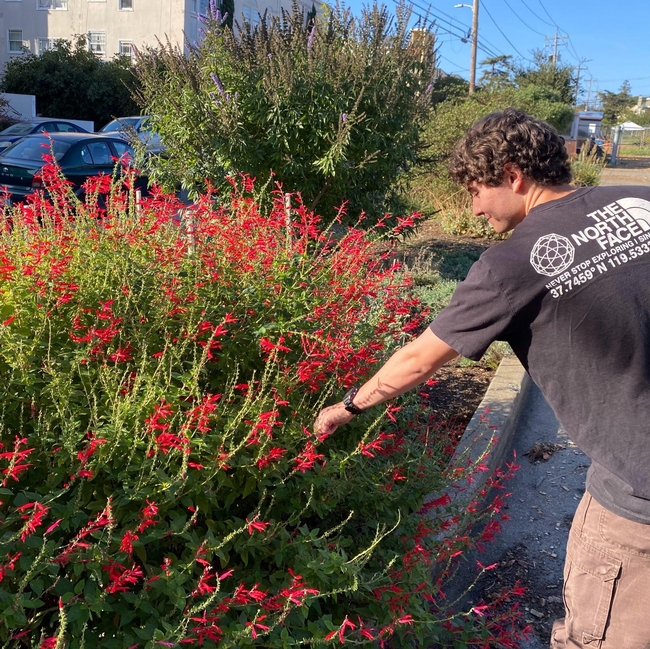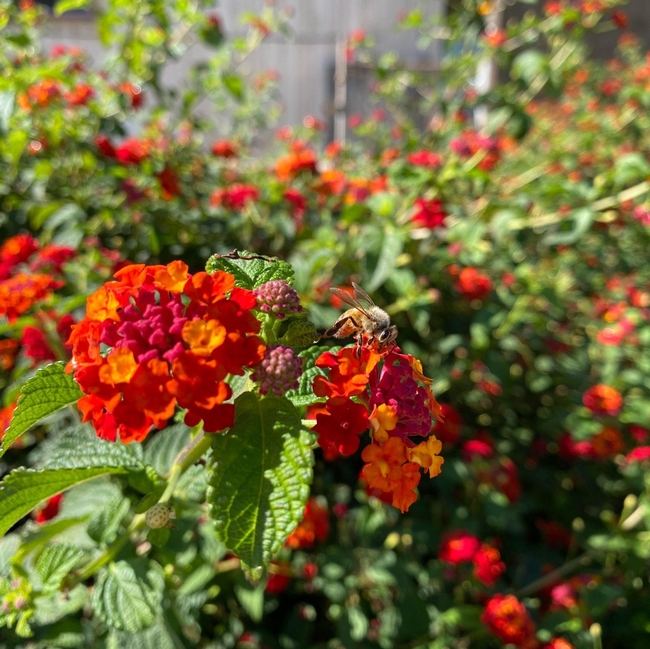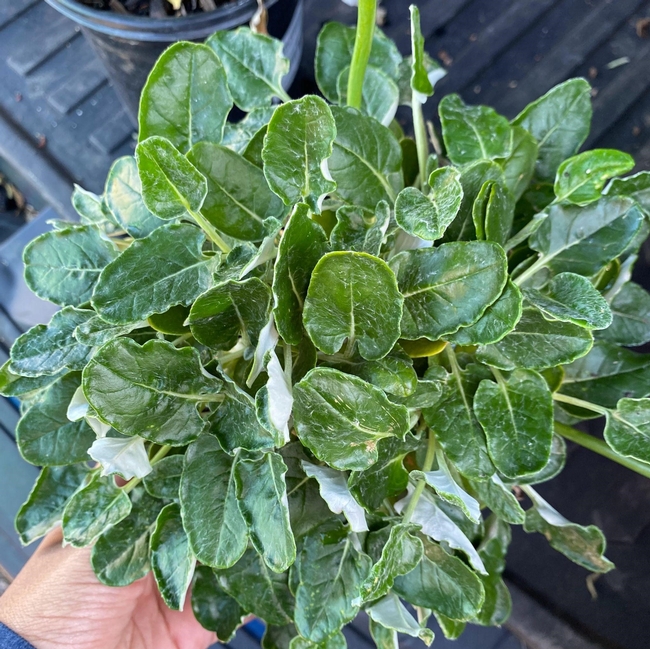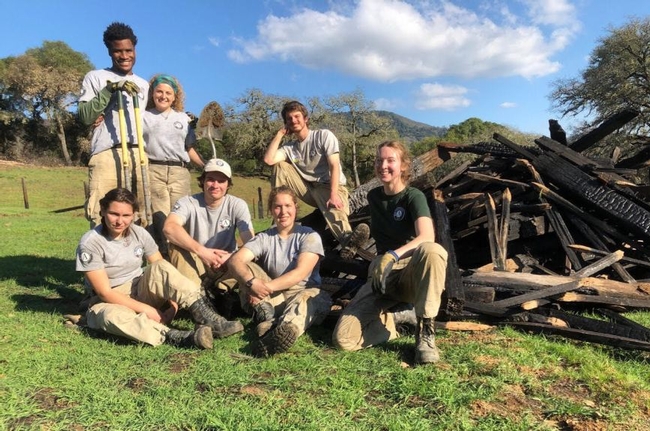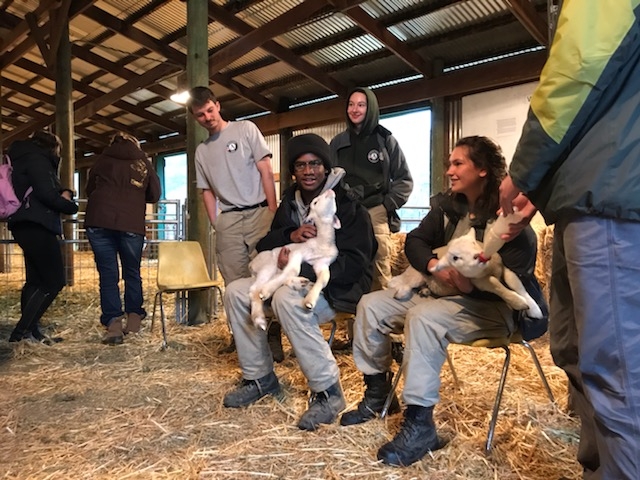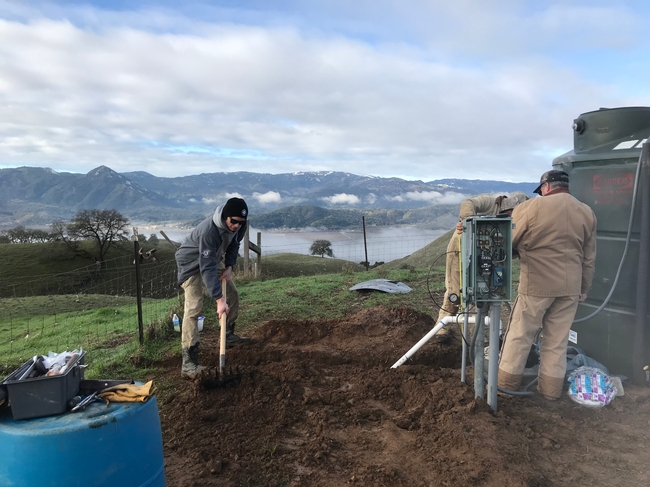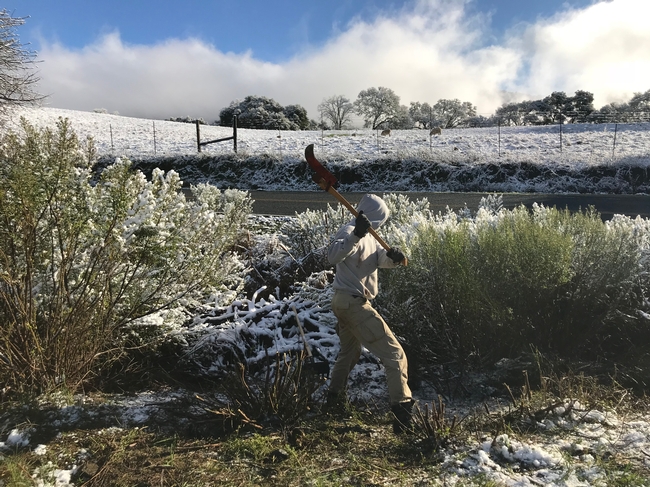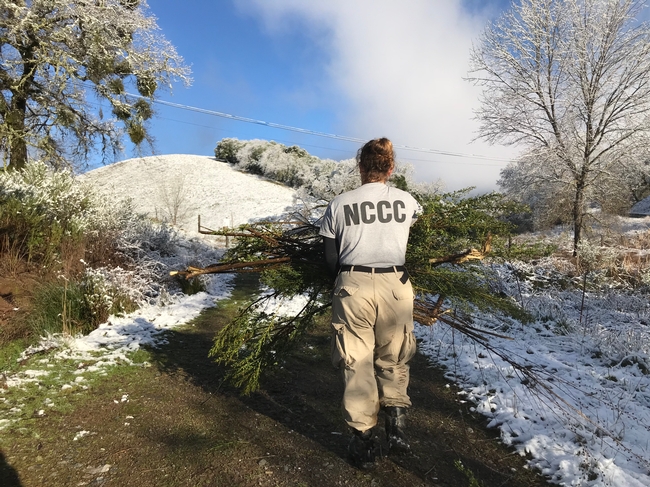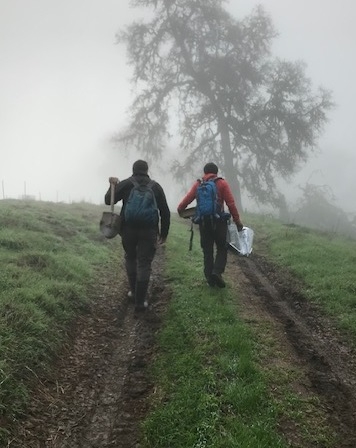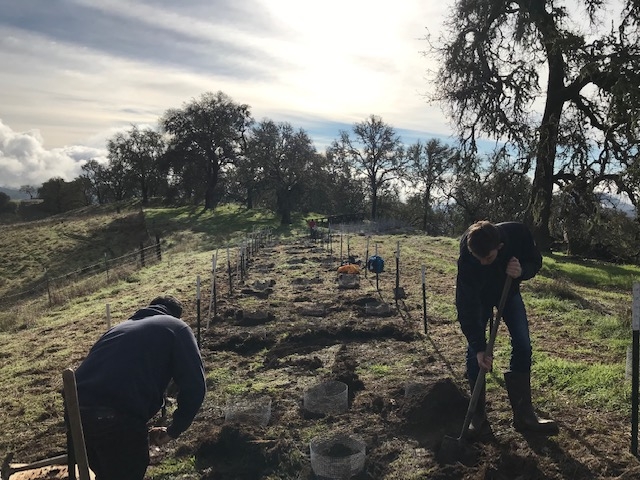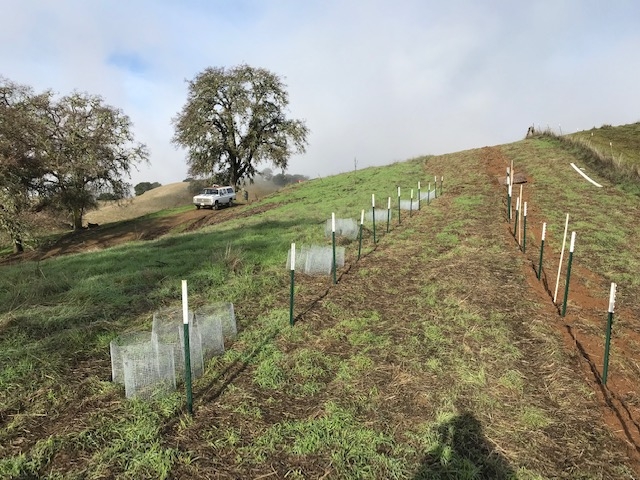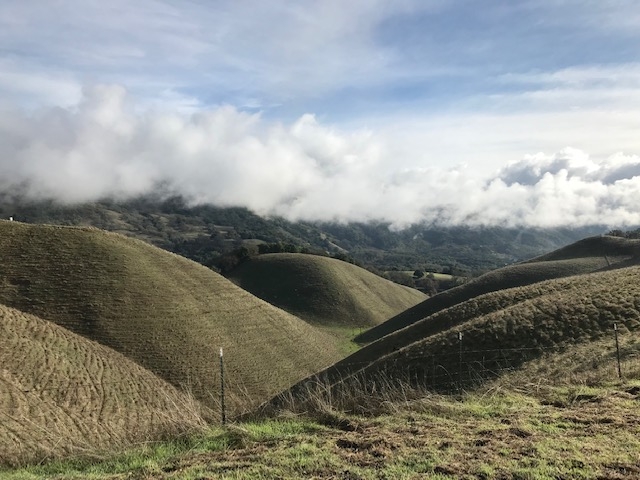- Author: Lily Elola
Fungal-Bacterial Interactions: Bridging Soil Niches in Regulating Carbon and Nitrogen Processes
Grasslands play a vital role in the nutrient cycling process of both carbon and nitrogen. The state of California is home to perennial and annual grasslands, distinguished from one another by their growth patterns. Annual grasses complete their growth cycle in a single season, whereas perennial grasses exhibit persistent growth throughout the year. Perennial grasses often develop extensive root systems that provide a more stable mechanism for long term carbon storage than their annual counterparts. Historically, three disturbances contributed to the conversion of California's former native perennial grasses to its current annual-dominated status: European colonization, fire-suppression, and drought.
Oak-woodland adjacent annual grasslands here in Hopland offer a distinctive seasonal rhythm. The growth season of this grass begins when rainfall is hearty enough to germinate grass seeds, typically during the late fall/winter. While characterized by herbaceous vegetation, the structure of these grasslands depends greatly on local weather and livestock grazing patterns. Because the life cycle of annual grass is limited to a single growing season, there is less time for it to contribute to long-term carbon storage. This means that the nutrient cycling process in an annual grassland ecosystem is primarily the job of biotic reactions between fungi and bacteria below the surface of the grass, in its soil. The Hopland Research and Extension Center (HREC) and soil microbial ecologist Dr. Mengting “Maggie” Yuan from UC Berkeley's Firestone Lab have teamed up to better understand how these biotic interactions in soil are affected by reduced precipitation conditions associated with climate change.
Dr. Mengting “Maggie” Yuan in the UC Berkeley Firestone Lab
Oxford Tract, Berkeley CA
Dr. Yuan's interest in natural resources began when her family would spend time walking together outside. This time spent in nature inspired her to think about the complexities of a much smaller biotic world. What kind of systems contribute to the function of smaller microbial ecosystems? She asked herself. This curiosity eventually led her to study environmental engineering in university. In 2011, she earned her Bachelor's degree in Environmental Engineering from Tsinghua University in Beijing. After which, she moved to the United States to earn her Ph.D. in Microbiology from the University of Oklahoma in 2017.
In the world of ecology, specifically soil microbial ecology, there exists promising opportunities for innovation and scientific advancement. Dr. Yuan points out that there is no standardized model for measuring the Biological Fertility Index (BFI) of soil, because scientists don't understand on a fundamental level the heterogeneity of the soil. The analytical methods scientists use currently to measure soil fertility point more to a soil's habitat than its biotic function.
“A scoop of soil contains, on a more microscopic level, mineral surfaces and pore space” says Dr. Yuan. “It's important that future research considers the spatial difference instead of potential.” She admits that understanding soil on a spatial level is a challenging facet of soil microbial ecology. She calls this her “lifelong challenge.” Still, she hopes to work towards projects like these that create well defined frameworks for describing the probability of microbes to be able to interact with the environment and other microbes.
Fungal ingrowth cores, used to allow fungal hyphae into soil core samples
Oxford Tract, Berkeley CA
Spectrometer equipment, owned by Lawrence Livermore National Laboratory
Oxford Tract, Berkeley CA
When it comes to staying up to date with advancements in microbial soil ecology, Dr. Yuan relies on her undergraduate researchers just as much as her postdoctoral colleagues. She cites collaboration as the mechanism of understanding what's going on in both her scientific community, and the greater academic community at UC Berkeley. She loves talking to undergraduates one-on-one to get a better understanding of their struggles and motivations for pursuing a career in natural resource science. Dr. Yuan says that, from her personal experience at UC Berkeley, “Students nowadays have a more developed understanding of their passion for climate action” and “bring to the table a valuable skill set missing from current climate solutions”. She is optimistic that undergraduate eagerness to participate in climate action research is indicative of a larger generational interest.
It was collaboration, flexibility, and the opportunity to connect with people on a national scale that encouraged Dr. Yuan to work on projects like these at UC Berkeley. She feels grateful that working in academia has allowed her the freedom to try and pose solutions to some of the state's most complex natural resource issues. Her work on this project holds profound implications for agriculture, environmental sustainability, and our understanding of climate change adaptation. The study's relevance extends far beyond the confines of HREC, as its findings will offer valuable insights applicable to other annual grassland areas in California, ultimately guiding land conservation and management strategies all around the state.
- Author: Lily Elola, HREC GrizzlyCorps Fellow
The California Department of Food and Agriculture's Healthy Soil Program provides funding for on-farm initiatives aimed at implementing soil practices that reduce greenhouse gas emissions and enhance carbon storage. The UC Hopland Healthy Soils Project was created in collaboration with the Hopland Research and Extension Center (HREC) and undertaken by UC Berkeley's Dr. Gordon Frankie to assess the impact of various hedgerow plant species on pollinator diversity. Hedgerows typically consist of shrubs, trees, grasses, and flowering plants that offer various advantages to the surrounding farm ecosystem. These advantages include but are not limited to: weed control, windbreak, erosion control, improved air and water quality, biodiversity enhancement, and increased pollinator activity.
To measure the effect of the hedgerows on pollinator activity, Dr. Frankie and his team at the UC Berkeley Urban Bee Lab conduct bee surveys on both the treatment area (hedgerow) and the control area (weeds and grasses) four times a year during spring, summer, and fall. The ultimate objective of this project is to strike an ecological balance by selecting plant species that benefit a range of organisms such as bees, birds, butterflies, and others, while simultaneously mitigating greenhouse gas emissions and sequestering carbon in the farm soil.
Assistant Researcher Jerid Vega with Pineapple Sage (Salvia elegans) at the Urban Bee Lab Garden in Berkeley, CA
Dr. Frankie, with the UC Berkeley Department of Environmental Science, Policy, and Management, is an urban entomologist with over 25 years of experience focusing on the behavioral ecology and community organization of solitary bee species in specific environments within California and Costa Rica. Over the past two decades, Dr. Frankie has conducted extensive studies on bee diversity, seasonality, and host plant preferences at various sites in northern California and seasonal dry forests in Costa Rica. His research also involves monitoring changes in annual bee frequencies and mortality factors that may impact bee populations. Recently, Dr. Frankie's work has shifted from pure wildland studies to comparative bee studies in both wildlands and urban residential gardens, driven by the discovery that urban areas can support diverse local bee species. This shift aligns with a broader concern of global pollinator decline and the need to find new ways to conserve and protect pollinators across different habitats.
A pollinator visiting Lantana or Shrub Verbena (Lantana camara) at the Urban Bee Lab Garden in Berkeley, CA
Dr. Frankie and his assistant researcher Jerid Vega recently stopped by HREC to add herbaceous plants and flower seeds to their project's test hedgerow. Jerid graduated from Berkeley in the spring of 2023 with a B.S. in Molecular Biology from UC Berkeley's College of Natural Resources. Both Dr. Frankie and Jerid argue there is inherent value in recognizing what biodiversity is. “Supporting that biodiversity can be achieved through investments in smaller, more pollinator friendly gardens” says Vega.
Admittedly, Dr. Frankie acknowledges that picking plants for the hedgerow and observing their relationships with pollinator visitors is a very slow process. The time it takes for plant species to establish can be an obstacle to speedy species surveying. When asked how their research team selects and manages the plant species for a specific project, Dr. Frankie and Jerid credit nursery workers, master gardeners, and community members for their suggestions. Dr. Frankie's ideology on plant selection is collective, the product of conversation about pollinator activity from his team, colleagues, and master gardeners. “Those are the people who spend time with the plants, watching them far more than I do!” Dr. Frankie chimes.
Urban Bee Lab Garden in Berkeley, CA
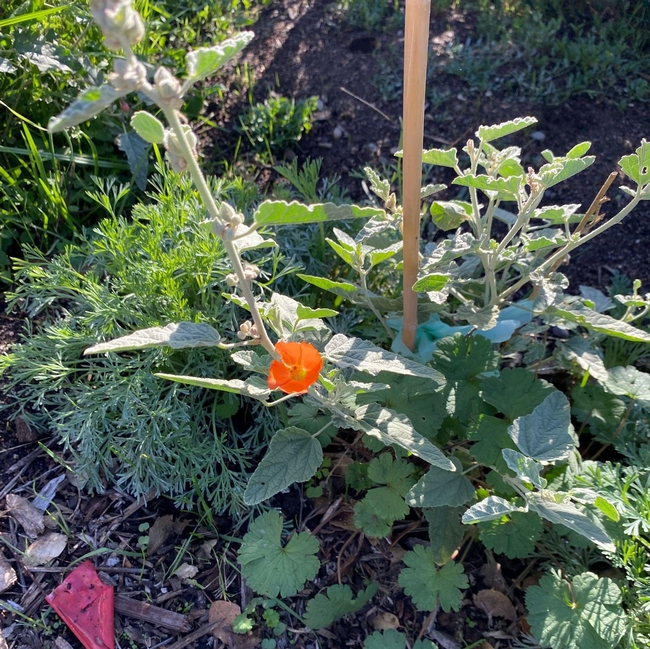
The Desert Mallow and native Redflower Buckwheat (pictured below) are just two of the many plant species that Dr. Frankie and his research team are in the process of observing. These native wildflowers not only produce striking, colorful blooms but also offer a wealth of nectar and pollen, making them a valuable food source for bees, butterflies, and other beneficial insects. Their extended blooming periods, typically from spring through late summer, ensure a consistent supply of sustenance for pollinators throughout the season. Additionally, both plants are well-adapted to arid and semi-arid regions, making them resilient and low-maintenance choices for gardeners. The Desert Mallow and Redflower Buckwheat exemplify the harmonious relationship between native plants and their pollinator counterparts that enhances biodiversity and contributes to a healthier ecosystem.
It's important to recognize that these pretty flowers attract all kinds of insects that aren't as suitable to some as the docile hummingbird. “It's not just bumble bees that these plants attract, it's wasps and flies that do their own part in benefiting ecosystem biodiversity,” adds Jerid Vega. The myth of insect pollinators being inherently eager to sting humans can be a significant obstacle in the way of convincing people to plant pollinator-friendly gardens. This fear of insects perpetuates reluctance to support both wildland and urban insect populations. In reality, these insects are not naturally aggressive toward people. “They're primarily focused on foraging for nectar/pollen to feed their colonies, and will only sting as a last resort if they feel threatened or cornered” concludes Jerid.
Educating people about the behavior and importance of bees and other pollinators is crucial. Dispelling the myth that bees are out to sting us can encourage more individuals to embrace pollinator-attracting plants, contributing to the conservation of these vital species. Understanding the true nature of bees and their role in pollination can lead to a more harmonious coexistence between humans and these remarkable insects.
When asked what potential small gardens with pollinator-preferred species have to attract a high diversity of bee species, Dr. Frankie provided some examples of encouraging results starting with his lab at the Oxford Tract. When the Bee Lab first moved to this site off campus, they started with bare soil. Since moving there full time in 2020, the garden has attracted over sixty species of native bees. The Bee Lab has also consulted on community gardens outside of the Bay Area in the past, including Emerson Community Garden in San Luis Obispo and a Diverse Home Garden in Ukiah. Emerson Community Garden surveyed 5 native bee species pre-planting and 42 species post-establishment. Diverse Home Garden in Ukiah surpassed that of Emerson, surveying 65 bee species in total over the course of 12 years.
The Bee Lab does their work with the help of community educators and a select group of volunteers primarily composed of undergraduate students interested in entomology, resource studies, or environmental conservation. Dr. Frankie's team sifts through volunteer applications annually, and are attracted to students they know will stay on board and have an interest in community outreach. Despite The Bee Lab being a small non-profit entity, they still respond to any invitations they can asking for lessons about pollinator vs. plant relationships.
Learn more about the UC Berkeley Bee Lab here.
This project was supported by funding through the CDFA's Healthy Soils Demonstration Program and 'California Climate Investments'. The HREC Hedgerow Demonstration Project is part of California Climate Investments, a statewide initiative that puts billions of Cap-and-Trade dollars to work reducing greenhouse gas emissions, strengthening the economy, and improving public health and the environment - particularly in disadvantaged communities.
- Author: Hannah Bird
The wonderful NCCC Gold Seven team have been working at HREC for the past 3 weeks, they have been so helpful - all the HREC staff will be so very sad to see them go! In this blog post we learn a little about the team members and get an overview of the work that they have been involved in, the interviews were conducted by Hannah Wood, the media lead for the team.
As the AmeriCorps NCCC team stationed at the UC ANR Hopland Research and Extension Center, we've had plenty of projects to keep us busy! In the three weeks we've been volunteering here, we've helped repair fence lines previously burnt in the River Fire, were put in charge of some daily barn chores, helped build infrastructure for upcoming research projects, assisted with K-12 educational programs, cleared brush, helped tidy up the place, and sometimes worked closely with the sheep (tagging, paint branding, raising bummer lambs, and giving vaccines).
Although the work was daunting at times, and the weather was never perfect, we were thankful to be working and living on this beautiful property right alongside the welcoming staff and their families. We learned loads of information about California seasons and climates, lambing, the important research projects going on, Northern California ecosystems, wildlife in the area, and wildfire mitigation and recovery. And the baby lambs made our days brighter… even with rainy skies!
I've asked a few of my fellow Corps members some questions about their personal experiences at the UC ANR Hopland Research and Extension Center… and here's what they said!
Q: What was your favorite part of volunteering at HREC?
I enjoyed learning a ton from the very knowledgeable HREC staff. Their welcoming attitude enabled us to get a firsthand experience of what living and working at a research extension center entails. We worked with each and every person on staff and they all showed us the details and unique experiences of their work duties, while also being very open and friendly toward us.
-Jared Gasper: 19 yrs old, from Nebraska
Q: What has made your experience at HREC?
I liked getting insight into the life of a shepherd and seeing the day to day responsibilities of working on a ranch. I also really enjoyed learning about all the research projects! Overall my time here has been extremely educational and useful for developing myself and my interests, specifically when working with the Forest Advisor for Mendocino Lake and Sonoma counties on post fire vegetation plot surveys.
-Dariel Echanis: 18 yrs old, from Vermont
Q: What's it like living at the HREC?
I think we all can say it's been extremely comfortable living and working on the HREC campus. We were very cozy in the dorm house, and enjoyed going for hikes and doing physical training on our off time.. which included beautiful views of course! Hannah Bird made us feel right at home with her caring and immediate attention, giving us fresh lamb meat, welcoming us into her home for dinner, and making sure we were always having new and exciting experiences:)
-Hannah Wood: 22 yrs old, from New York State
Q: What was it like as the Team Leader coordinating daily projects with the staff?
The staff at HREC are all incredibly helpful and organized so I had a really great experience working with them. I never had trouble getting into contact with anyone and every member of the staff was happy to answer questions. The team got to work with a number of staff members who all had diverse bodies of knowledge and we learned a lot from them! Working at HREC has been a wonderful experience for me and for the team.
-Jessi Hagelshaw: 22 yrs old, from California
Q: What was it like volunteering on the weekends with the Ukiah Animal Shelter?
It was really rewarding! It was good to see that none of the animals we worked with before Christmas break were still there when we returned in January. I'm glad we got a chance to help out and I would love to do more work with animal shelters in the places we'll work at in the future.
-Alex Faeth: 22 yrs old, from New Jersey
Q: How was it working with the K-12th graders that came to HREC to learn about sheep?
Working with the school children was a great experience. The weather was cold and wet a lot of the days we did field trips but the teachers and students were enthusiastic to hike the property, which in turn, energized the staff and volunteers!
-Danny Zoborowski: 24 yrs old, from New York State
Q: Anything you'd like to say to the HREC and Hopland/Ukiah communities?
HREC's hospitality was great. The entire staff was welcoming and helpful, the dorms are nice and cozy, the land is beautiful, and it is a great place to hike... or just roam. Thank you HREC staff!
-Amir Corbett: 20 yrs old, from Pennsylvania
Amir and Alex show the "bummer" or adopted lambs to the K-12 students.
Hard work on the hill!
All the Americorps Gold Seven team worked so hard rain, snow or shine!
Clearing brush, to be prepared for future fire was one of the key tasks that the team helped HREC with.
- Author: Valentina Evans
My name is Valentina Evans, and I am a new volunteer at the UC Hopland Research and Extension Center. My partners Benjamin Evans, and Zane Petersen have chosen to volunteer with me at the HREC for our senior project at Ukiah High School. A few weeks ago on the twenty-first of December we volunteered to help two researchers, Paulo who studied at UC Santa Cruz, and Wyath, who is still studying at Humboldt State University, to plant acorns from different ecosystems, and analyze how they will adapt to conditions with more water, less water, more sunlight or a lack of sunlight. This study is part of Dr. Blair McLaughin's study from the Zavaleta Lab at UC Santa Cruz.
We started off by digging holes about 1 foot deep and laying a thin square piece of chicken wire at the bottom of the holes to prevent gophers from entering and eating the acorns. We then took a circular strip of chicken wire and placed it on top of the flattened piece at the bottom. With the second strip of chicken wire standing horizontal, we continued by covering the holes with the same dirt we originally dug out. Now with the metal secured in place, Paulo came around and gently placed the acorns inside of the holes. The hands-on experience was extremely fascinating, not to mention peaceful. The view at the top of the hill was breathtaking, and the weather was just perfect. The entire process was tiring, but having had the opportunity to participate in a lab/research project made the whole experience worth it.
Although the project will not produce any data until the acorns sprout, the idea behind the project is captivating. Paulo and Wyath are studying the growth of oak trees from all sorts of climates, locations, and ecosystems. Some of the acorns are from northern California and others from way down in southern California. They will be monitoring the water levels, and amount of sunlight the oak trees will receive, all in hopes to see how the oak trees will adapt to different changes in their environments. Seeing as how I want to major in Biological Sciences in college, this experience was exceptionally informative for me and has taught me how critical patience, effort and time are in order to successfully accomplish a lab and receive the most accurate facts. I am very grateful to have been able to participate in this ongoing project and am looking forward to continuing to be a part of the younger generation who can benefit from having the Hopland Research and Extension Center available to us, to further our knowledge about the environment.

